电路原理课件讲义英文版 Chapter_2汇总
- 格式:ppt
- 大小:1.96 MB
- 文档页数:36

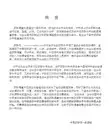
Theories of Electrical Circuits Lecture 2 Tsinghua University 2007第2讲电阻、电源和基尔霍夫定律Theories of Electrical Circuits Lecture 2 Tsinghua University 2007•线性元件特性•独立源•受控源•基尔霍夫定律电阻电压源, 电流源KVL, KCLTheories of Electrical Circuits Lecture 2 Tsinghua University 20072.1 电阻元件(resistor)线性定常电阻元件:任何时刻端电压与其电流成正比的电阻元件。
1. 符号(1) 电压与电流取关联参考方向2.欧姆定律(Ohm’s Law)u =R i电阻R (resistance)单位名称:欧(姆) 符号: Ωk ΩM ΩR +uiRTheories of Electrical Circuits Lecture 2 Tsinghua University 2007令G =1/RG 称为电导(conductance)则欧姆定律表示为i =G u单位名称:西(门子) 符号: S (Siemens)R ∝tg α♦线性电阻R 的电阻值是一个与电压和电流无关的常数。
线性电阻元件的伏安特性为一条过原点的直线αuiG+uiTheories of Electrical Circuits Lecture 2 Tsinghua University 2007(2) 电阻的电压和电流取非关联参考方向R (G )+ui则欧姆定律写为u =–Ri i =–Gu♦公式必须和参考方向配套使用!Theories of Electrical Circuits Lecture 2 Tsinghua University 20073. 功率和能量p 吸=–ui =–(–R i ) i =i 2R=–u (–u/ R ) = u 2/ Rp 吸=ui =i 2R =u 2/ R功率:R+uiR+ui能量:可用功率表示。
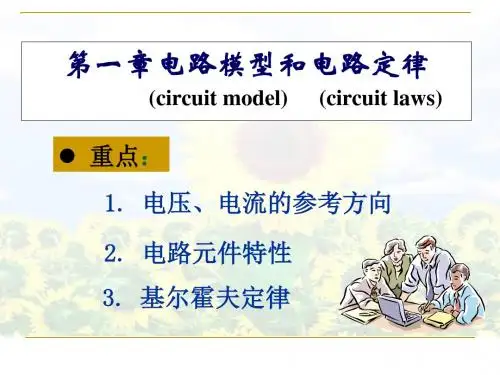

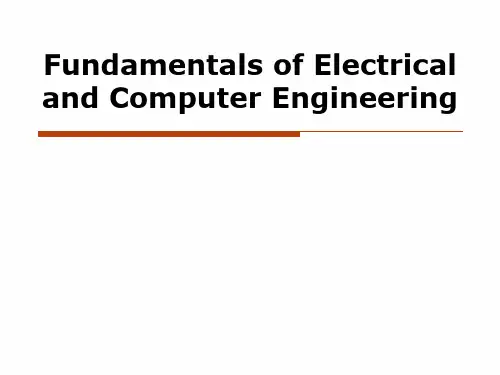

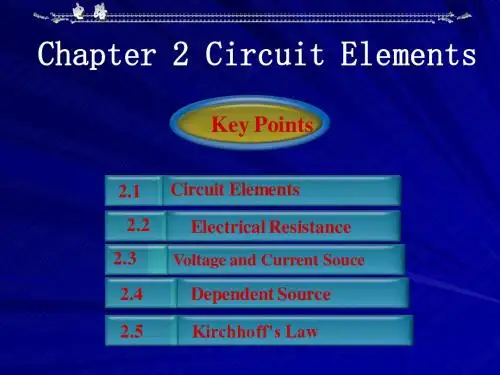
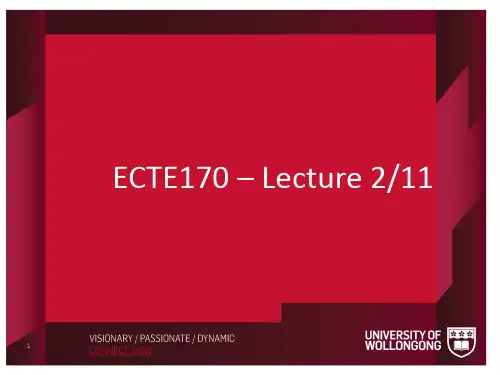
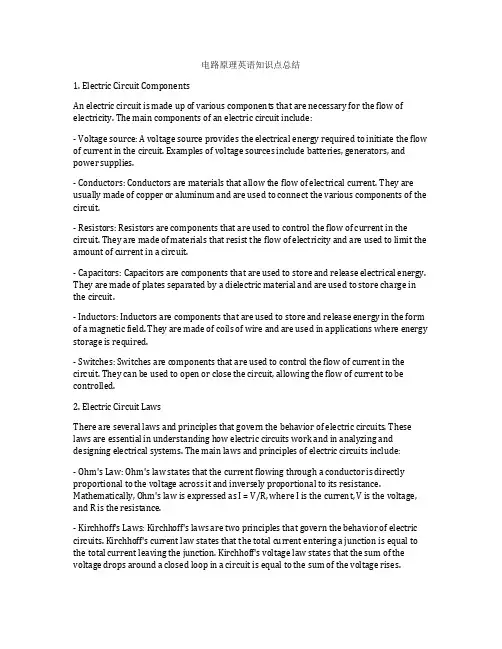
电路原理英语知识点总结1. Electric Circuit ComponentsAn electric circuit is made up of various components that are necessary for the flow of electricity. The main components of an electric circuit include:- Voltage source: A voltage source provides the electrical energy required to initiate the flow of current in the circuit. Examples of voltage sources include batteries, generators, and power supplies.- Conductors: Conductors are materials that allow the flow of electrical current. They are usually made of copper or aluminum and are used to connect the various components of the circuit.- Resistors: Resistors are components that are used to control the flow of current in the circuit. They are made of materials that resist the flow of electricity and are used to limit the amount of current in a circuit.- Capacitors: Capacitors are components that are used to store and release electrical energy. They are made of plates separated by a dielectric material and are used to store charge in the circuit.- Inductors: Inductors are components that are used to store and release energy in the form of a magnetic field. They are made of coils of wire and are used in applications where energy storage is required.- Switches: Switches are components that are used to control the flow of current in the circuit. They can be used to open or close the circuit, allowing the flow of current to be controlled.2. Electric Circuit LawsThere are several laws and principles that govern the behavior of electric circuits. These laws are essential in understanding how electric circuits work and in analyzing and designing electrical systems. The main laws and principles of electric circuits include:- Ohm's Law: Ohm's law states that the current flowing through a conductor is directly proportional to the voltage across it and inversely proportional to its resistance. Mathematically, Ohm's law is expressed as I = V/R, where I is the current, V is the voltage, and R is the resistance.- Kirchhoff's Laws: Kirchhoff's laws are two principles that govern the behavior of electric circuits. Kirchhoff's current law states that the total current entering a junction is equal to the total current leaving the junction. Kirchhoff's voltage law states that the sum of the voltage drops around a closed loop in a circuit is equal to the sum of the voltage rises.- Thevenin's Theorem: Thevenin's theorem states that any linear electrical network can be replaced by an equivalent circuit consisting of a single voltage source and a single series resistor, where the voltage source is equal to the open-circuit voltage and the series resistor is equal to the Thevenin resistance.- Norton's Theorem: Norton's theorem is similar to Thevenin's theorem and states that any linear electrical network can be replaced by an equivalent circuit consisting of a single current source and a single parallel resistor, where the current source is equal to the short-circuit current and the parallel resistor is equal to the Norton resistance.- Maximum Power Transfer Theorem: The maximum power transfer theorem states that the maximum power is transferred from a source to a load when the load resistance is equal to the source resistance.3. Series and Parallel CircuitsElectric circuits can be connected in two ways: series and parallel. In a series circuit, the components are connected end-to-end, so that the current flows through each component in sequence. In a parallel circuit, the components are connected across each other, so that the current is divided and flows through each component simultaneously. Understanding the behavior of series and parallel circuits is important in the analysis and design of electrical systems.In a series circuit, the total resistance is the sum of the individual resistances, and the total voltage is the sum of the individual voltages. The current is the same in all components in a series circuit. In a parallel circuit, the total resistance is the reciprocal of the sum of the reciprocals of the individual resistances, and the total current is the sum of the individual currents. The voltage is the same across all components in a parallel circuit.4. Applications of Electric CircuitsElectric circuits have numerous applications in a wide range of electrical and electronics systems. Some of the key applications of electric circuits include:- Power distribution: Electric circuits are used to distribute electrical power from the source to the various loads in a system. Power distribution systems are essential in providing electricity to homes, industries, and other facilities.- Electronic devices: Electric circuits are used in the design and development of electronic devices, such as computers, smartphones, televisions, and other consumer electronics. The behavior of electric circuits is fundamental to the operation of these devices.- Control systems: Electric circuits are used in the design of control systems that are used to regulate and control the behavior of various systems. Control systems are used in industrial automation, robotics, and other applications.- Communication systems: Electric circuits are used in the design of communication systems, such as telecommunication networks, wireless communication systems, and satellite communication systems. These systems rely on the behavior of electric circuits to transmit and receive signals.- Renewable energy systems: Electric circuits are used in the design and implementation of renewable energy systems, such as solar power systems, wind power systems, and hydroelectric power systems. These systems rely on the behavior of electric circuits to convert and distribute the generated electrical energy.In conclusion, electric circuits are essential in the study and application of electrical engineering and technology. Understanding the principles of electric circuits, including their components, laws, behavior, and applications, is crucial in the design, analysis, and operation of electrical and electronics systems. Whether it is power distribution, electronic devices, control systems, communication systems, or renewable energy systems, electric circuits play a critical role in the functioning of modern electrical and electronic systems.。
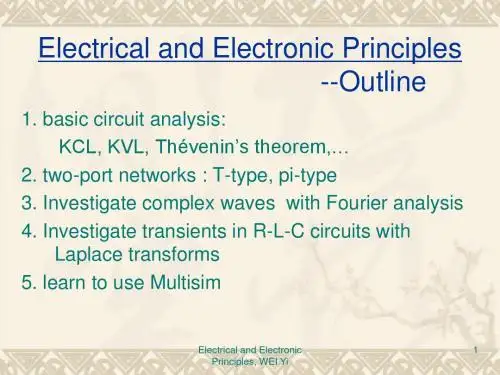
![[工学]英语班电力电子技术第二章Chapter](https://uimg.taocdn.com/ebeae14c7375a417876f8f38.webp)
Teaching ProgramCourse Code: 101C0040Course Name: Electric Circuits (Ⅰ)Weekly Hours: 4.0-0 Credits: 4.0Teaching Goal and Basic Requirements:This course introduces the principles of circuits and their role in electrical engineering, then introduces and demonstrates the power of the fundamental circuit laws and analysis methods. This is followed by an introduction to the principle of operational amplifier properties and operational amplifier circuits. The properties and applications of reactive circuit elements are introduced along with first and second order circuits. The basics of AC circuit analysis follow, the course will show how the sinusoidal steady state problem can be solved using phasor analysis. Students are prepared to analyze circuit properties with these tools and methods for each circuit type using both manual methods and PSpice tools.Content of Courses & Hours Allocation:Autumn QuarterWeek 1: Introduction; Chapter 1-- Basic concepts;Week 2: Chapter 2-- Basic laws; Chapter 3--Nodal analysis;Week 3: Chapter 3--Mesh analysis; Chapter 4--Linearity property, superposition, source transformation;Week 4: National Holiday;Week 5: Chapter 4--Thevenin’s theorem, Norton’s theorem, Maximum power transfer;Week 6: Chapter 5--Operational amplifiers; Quiz 1;Week 7: Chapter 6--Capacitors and inductors; Chapter 7--First-order circuits: Source-free circuit;Week 8: Chapter 7--Step response; Chapter 8--Second-order circuits;Week 9: Chapter 9--Sinusoids and phasors;Winter QuarterWeek 1: Chapter 10--Sinusoidal steady-state analysis; Quiz 2;Week 2: Circuit analysis with Pspice; Lab exercise--Circuit analysis with Pspice;Week 3: Chapter 11--AC power analysis: Effective or RMS value, Power factor;Week 4: Chapter 12--Three-phase circuits; Power in a system;Week 5: Chapter 13--Magnetically coupled circuits: Mutual inductance; Linear transformers, Ideal autotransformers;Week 6: Chapter 14--Frequency response: Transfer function, Resonance; Quiz 3;Week 7: New Year Holiday; Chapter 14--Passive filters; Circuit applications;Week 8: Chapter 16--The Fourier series: Average and RMS value; Review;Week 9: Review;Teaching Plan:The course grade is calculated based on:Homework 10%, Quiz 30% (two top scores from 3 quiz, 15% each), PSpice Assignment 5%, Final Exam: 55%Homework will be given full credit if the work is completed and the solutions understandable.Recommended Textbooks and Other References: (books, editors, publishing company,publishing time)1.Fundamentals of Electric Circuits,Charles K. Alexander, Matthew N.O. Sadiku,McGraw-Hill Companies Inc,2000.122.PSpice and MATLAB for Electric Circuit Analysis,Tong Mei,Machine Industry Press,2005.73.Principles of Electric Circuits,Fan Chengzhi,Sun Dun,Tong Mei,Machine Industry Press,2005.74.Electric Circuits (Four Edition),Qiu Guanyuan,High Education Press,1999.65.Electric Circuits (Six Edition),James W. Nilsson, Susan A. Riedel, Publishing House of Electronics Industry,2002.6Teaching ProgramCourse Code: 101C0050Course Name: Electric Circuits (II)Weekly Hours: 4.0-0 Credits: 2.0Teaching Goal and Basic Requirements:Transient response analysis, network functions, poles and zeros; solution of network equations using Laplace transforms, inverse transforms, convolution integral, two-port networks. Matrix formulation of circuit equations, nodal Analysis and mesh analysis. Introduction of distributed circuits, distributed circuits of finite length, traveling wave, lossless transmission line of finite length. Analysis of nonlinear circuits, linearized circuit models, small signal analysis. Circuit analysis with MATLAB.Content of Courses & Hours Allocation:Spring QuarterWeek 1: Chapter 15--Definition of Laplace transform; Properties of the Laplace transform; The inverse Laplace transform; Application to circuits; Transfer function;Week 2: The convolution integral; Network function and step response;Week 3: State variables and state equations; Circuit analysis with MATLAB;Week 4: Chapter 18--Two-port networks; Supplement 1: Matrix equations for network--Nodal Analysis;Week 5: Supplement 1: Matrix equations for network--Mesh Analysis;Week 6: Supplement 2: Distributed Circuits--Introduction, distributed circuits of finite length;Week 7: Supplement 2: Traveling wave; Lossless transmission line of finite length; Circuit analysis with MATLAB; Midterm exam;Week 8: Supplement 3: Simple nonlinear circuits--Introduction, Nonlinear resistor circuits, Small signal analysis; Review;Week 9: Review;Teaching Plan:The course grade is calculated based on:Homework 10%, Quiz 5%, Midterm 15%, MATLAB Assignment 10%, Final Exam 60%Homework will be given full credit if the work is completed and the solutions understandable.Recommended Textbooks and Other References: (books, editors, publishing company,publishing time)1.Fundamentals of Electric Circuits,Charles K. Alexander, Matthew N.O. Sadiku,McGraw-Hill Companies Inc,2000.122.Principles of Electric Circuits,Fan Chengzhi, Sun Dun, Tong Mei,Machine Industry Press,2004.73.PSpice and MATLAB for Electric Circuit Analysis,Tong Mei,Machine Industry Press,2005.74.Electric Circuits (Four Edition),Qiu Guanyuan,High Education Press,1999.65.Electric Circuits (Six Edition),James W. Nilsson, Susan A. Riedel, Publishing House of Electronics Industry,2002.6。